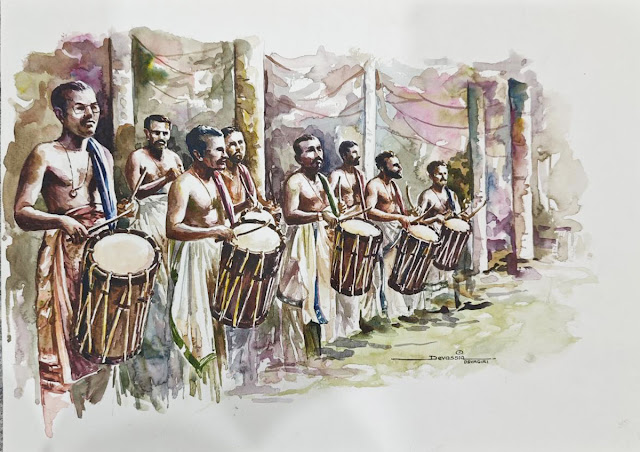NaPoWriMo: today’s prompt (optional, as always). Music features heavily in human rituals and celebrations. We play music at parties; we play it in parades, and at weddings. In her poem, OBIT [Music], Victoria Chang describes the role that music played in her mother’s funeral. Today, we challenge you to write a poem that involves music at a ceremony or event of some kind.
Today’s poem is an experiment in rhythm, repetition, and
musical energy. I drew inspiration from chenda melam, the vibrant
percussion ensemble tradition of Kerala, where sound, tempo, and movement build
in waves. This is my first time trying something like this, and I found the
process both exciting and meditative. Here's the poem:
 |
| Artist-Devassia-Devagiri |
Day Twenty Eight-NaPoWriMo – Let it Roll On
A Poem Inspired by Chenda Melam
Let it let it let it roll on
let it let it let it roll on
let it let it let it roll on
let it let it let it roll on
drums and sticks and drums and sticks on
drums and sticks and drums and sticks on
let it let it let it roll on
let it let it let it roll on
look here, look here, look here, swing on
look here, look there, look on swing on
let it roll on, let it slow down
let it trumpet, let it go on
swing here, swing there, let it move on
swing here, swing there, let it move on
let it let it let it roll on
let it let it let it roll on
bells and cymbals, cymbals play on
bells and cymbals, cymbals play on
sway here, sway there, let it cling on
sway here, sway there, let it cling on
let it roll on, let it speed up
let it roll on, let it speed up
letitletitletit rollon
letitletitletit rollon
letitletitletit rollon
letitletitletit rollon
Let me know what you think—or if you’ve ever tried writing with rhythm as your guide. This year's NaPoWriMo is concluding in three days!
Thanks for reading!



.jpg)